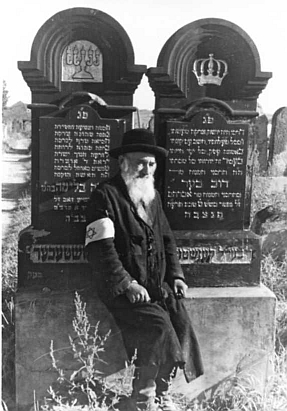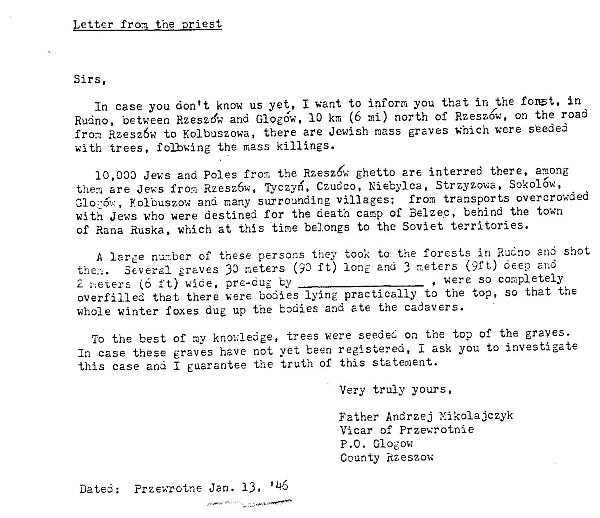The Holocaust
Note: The following photographs are in a reduced size. Just click on any image to see the full sized image. Then, click the back button on your browser to return to this page.
- The Story of the Photo of Mr. Moses in the Reishe Cemetery
- Letter From a Priest, 1946
- Message hidden in a picture frame in Rzeszow, 1940
- Nokhem Shternheim
The Story of the Photo of Mr. Moses in the Reishe Cemetery
By Marian Rubin, 2018
Mr. Moses, in the above photo, was photographed in front of the matzeva of Dov Ber Kestecher and his wife, Chana Blima Kestecher. It is unknown if Mr. Moses was a relative.
It is also unknown whether the Mr. Moses in the above photo is the same Moshe Moses (from Mielec) who appears in the Reich-Orgel-Moses Family photograph on this site. The Ansell family was unable to confirm it.
The photo was sent to me in April 2006 by Benjamin Zeev (Benny) Wexler in Jerusalem. Following is his message:
“Dear Marian
I send here few photos* which were taken by a German soldier in 1941 at the Reishe cemetery. The photos were sent to my family close friend, and actually my teacher, Rabbi Dr. Shlomo Tal z”l. The sender is Ms. Zehava Plevner from Stutgart, she sent it exactly 24 years ago**. After years of search she found this soldier who served near to Reishe. He told her that together with another officer they took these photos of “MR. Moses” in the cemetery. According to his story, Mr. Moses knew the officer, but he didn’t know whether the name Moses was family or surname***. Plevner presumes it is family name, because Germans do not address anybody in their surname*** especially when they use “Herr” [Mr.]”.
* The letter refers to photos, plural. I think that the others were very similar; taken at a slightly different angle.
** In 1982.
*** I think “surname” should be “first name”.
Letter From a Priest, 1946
By Marian Rubin, 2018
Note: I do not have a notation of how I obtained this letter.
Translation of the Priest’s original letter from Polish into English:
Sirs,
In case you don't know us yet, I want to inform you that in the forest, in
Rudno, between Rzeszów and Glogów, 10 km (6 mi) north of Rzeszów, on the road
from Rzeszów to Kolbuszowa, there are Jewish mass graves which were seeded
with trees, following the mass killings.
10,000 Jews and Poles from the Rzeszów ghetto are interred there, among
them are Jews from Rzeszów, Tyczyń, Czudco, Niebylca, Strzyzowa, Sokolów,
Glogów, Kolbuszow and many surrounding villages; from transports overcrowded
with Jews who were destined for the death camp of Belzec, behind the town
of Rana Ruska, which at this time belongs to the Soviet territories.
A large number of these persons they took to the forest in Rudno and shot
them. Several graves 30 meters (90 ft) long and 3 meters (9ft) deep and
2 meters (6 ft) wide, pre-dug by ___________________ , were so completely
overfilled that there were bodies lying practically to the top, so that the
whole winter foxes dug up the bodies and ate the cadavers.
To the best of my knowledge, trees were seeded on the top of the graves.
In case these graves have not yet been registered, I ask you to investigate
this case and I guarantee the truth of this statement.
Very truly yours,
Father Andrzej Mikolajczyk
Vicar of Przewrotnie
P.O. Glogow
County Rzeszow
Dated: Przewrotne Jan. 13, '46
Original letter in Polish:
Message Hidden in a Picture Frame in Rzeszow, 1940
Submitted by Andrea Axt, Montreal, Canada
This message, in Polish, was sent by an unknown source to the Jewish Historical Institute in Warsaw. The story as told to the JHI follows:
In approximately 2000, an elderly Polish couple in Rzeszow was moving out of their home. In the process of moving, a picture, framed by a Jewish glazier in Rzeszow in 1940, fell down. The frame broke and out of it fell the backing with this writing on it. Sometime after 2000, a copy was given to Andrea Axt by a friend on the staff of the JHI who knew that members of Andrea Axt’s AXT family in Rzeszow had been glaziers.
Translation by Andrea Axt
The Jewish nation is suffering terribly and this is because of the German nation wrote a Jew. the day 2/X 1940*
* October 2, 1940





